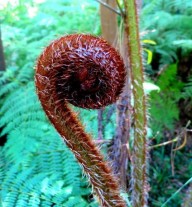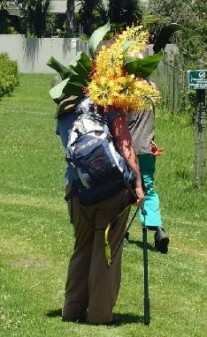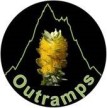
People, Poison and Pangas headed for the Witfontein Forests above the exclusive suburbs of Heatherlands and Glenbarrie. These forests are infested with every sort of alien. In particular, the invader tree fern from Australia is taking over the area, thus dooming Alsophila capensis (Cape Tree Fern) to extinction. In almost every garden in these affluent suburbs, Sphaeropteris cooperi (Aussie Tree fern) flourishes, producing huge amounts of spore to fuel the invasion. No action is taken to stem the tide. The plant is not proclaimed a noxious weed and is freely available in local nurseries. Even the conservation-minded ignore the problem and are happily giving house-room and TLC to this Doomsday plant.
Prix, who is the curator of the Southern Cape Herbarium, organised that we take a team of EPWP workers with us into the forests to destroy as many aliens as we could in a morning. They are employed at the Garden Route Botanical Garden and we badly needed their help. We are grateful that the trustees and senior staff made this joint alien clearing project possible. We started off with 9 and ended with 6 guys, as the going got tougher during the course of the day. We were also delighted that Greg and Cheryl Devine from the High Altitude Team of the Mountain Club were able to join 8 Outramps members for the morning.

Searing heat made it imperative that we should work mainly in the shade of the indigenous forest and the pine plantations. So we chopped, slashed and pulled out Aussie invaders and poisoned them with Garlan to prevent resprouting. The ferns that we pulled out, were hung in tree forks to prevent the roots touching the ground. It was heavy work, but rewarding to see 4m high Ferns and massive Bugweeds crashing to the ground. However, it would be naïve to think that we had even dented the numbers. You would require an army to do that. We also need to eradicate every single specimen of the fern that grows in the Southern Cape. They carry a huge number of spores that travel for many kilometers. See Nicky’s photo of “The Bad and the Good” and compare the spore numbers. The Alsophila capensis frond is on the right of the picture. Our own Tree Fern produces fewer spores and is very selective in its habitat requirements on the banks of streams and in deep shade. The invader will grow anywhere, even managing to thrive in full sun.

And if you thought that this monster was the only problem, think again. The beautiful Kahili Ginger plant with its exquisite yellow flowers (Hedychium gardnerianum), is also taking over. There is Bugweed, Wattle, a plethora of Pines and lots of the invasive Nephrolepis Fern, Cannas, Pampas Grass and Lantana, to mention but a few. If we are to preserve this area as a playground for mountain-bikers, hikers and dog-walkers, there needs to be a concerted effort from all these groups to eradicate the aliens. And time is running out. After the good rains of recent months, the invaders have made huge strides and the indigenous forest is shrinking. The Department of Water Affairs and Forestry also desperately needs to come to the party. It would seem that they control the land. One of the well-trained “Working for Water” teams would be the answer to the problem. It would keep them busy for months.
On a lighter note, WAGS chose Pepsi Pools as their Wednesday objective. The prevailing high temperatures made it the ideal choice for a hot day, with swimming in the stunning pools being an excellent option. We are hoping to go to Joubertina on Friday to hunt for Helichrysum outeniquense, which is Presumed Extinct. Jan Vlok has hunted and not found it, so we probably don’t even have an outside chance. It is described as, “Known only from the type collection. Allied to H. felinum but distinguished by its different habit, woollier leaves, and smaller heads with bracts in fewer series, arranged in a spreading corymbose panicle.” The original plant was discovered by the famous botanical explorer, Elsie Esterhuysen. But in February, it is necessary to look at temperatures before making field trip decisions. If it’s too hot on Friday, we will once again head for the forests and the shade.
Di Turner

CREW Group, Southern Cape
[The KTT blog team would like to thank Di Turner for sending us this wonderful article and giving us permission to use the accompanying photographs that were taken by the Outramps CREW members.]
